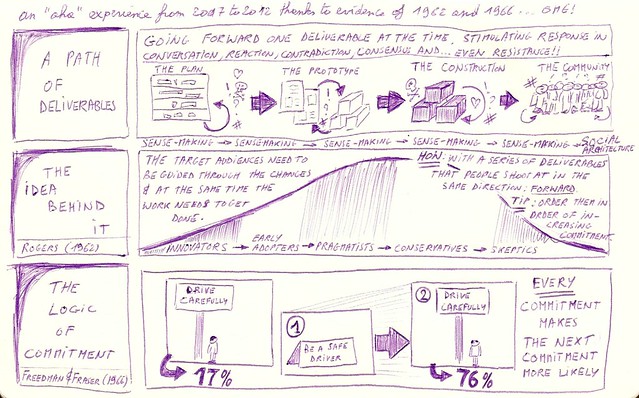Not sure that this blogpost will make much sense, because I will be describing an ‘aha’ moment that took me about five years. It’s pretty dense, so don’t feel obliged to finish it to the end. This blog is how I learn.
It all started with the question ‘How to eat the elephant of organizational change?’ that I asked myself more than 5 years ago.
A Path of Deliverables
In my experience, people make sense of the change as they react to the prototype of your deliverables. Therefore, the way to get your target audience moving is not by telling them “do something” but by carefully organizing our interventions. Not only will this improve the quality and the accuracy of the deliverables, it will also get their minds in motion and their noses pointed in the direction of the program.

As I have attempted to depict in the above diagram that so-called ‘path of deliverables’ is more than a maze to send your target audience into. In reality it plays out as a dialogue where opinions and emotions meet. Our role as an organizational change practitioner is to stimulate response and to create involvement.
The Idea Behind It
The chunks of the elephant are actually the same parts of the audience that you encounter while introducing a new product or initiative. The easiest way to describe them is through the logic of Everett Rogers in his 1962 book called The Diffusion of Innovations, where he stated that adopters of any new innovation or idea could be categorized on a classic bell-shaped curve as described here:
- Innovators (2.5 %) Venturesome, educated, multiple information sources, greater propensity to take risk;
- Early Adopters (13.5%) Social leaders, popular, educated;
- Early Majority (34%) Deliberate, many informal social contacts;
- Late Majority (34%) Skeptical, traditional, lower socio-economic status;
- Laggards (16%) Neighbors and friends are main information sources, fear of debt.
All these target audiences need to be guided through their change cycle, but at the same time the work needs to get done. The solution is to combine both and to provide a series of progressive and smart shaped deliverables that people can shoot at, nicely ordered in the same direction: forward one audience at a time. Our role as organizational change practitioners here is to be patient and to be prepared to do our evangelizing work all over again for each target audience that we meet. Knowledge is our biggest enemy in that case.
This is pretty much how far I got five years ago and today still, this is how I build organize my projects. However, since then there are two fundamental ingredients that I gladly add to this soup.
The Logic of Commitment
There is no point in postponing bad news or making the work look prettier than it really is. Target audiences need to go through the rollercoaster of emotions and pushbacks. But there is one thing we CAN do to make sure they don’t jump off and DO build commitment over time.
It all has to do with how we can influence the way these deliverables are ordered and paced over time. Once again I am jumping back to the sixties for evidence. In 1966 the researchers Freedman and Fraser found that people were more likely to agree about bigger request when asked for a small one first. They asked to put a “Drive Carefully” sign into people’s garden and only 17% agreed. However when they were asked to put a smaller sign “Be a Safe Driver” first and then after 2 weeks later big “Drive Carefully” sign 76% people agreed.
This goes to show that every commitment – how small and insignificant it may seem – makes the next commitment possible. This is why it makes sense to spend time with people. Our role as organizational change practitioners is not only to chunk the deliverables in reachable goals per target audience. We should do so in increasing order of commitment. Don’t ask for people to take ownership of the solution on the first meeting. Your success rate will resemble that of Freedman and Fraser at their first attempt.
The Fabric of Community
Spending quantity time (see also last week’s insight) is essential for people to buy-in to the solution and eventually take ownership of it. The plan becomes the prototype. Later it becomes the construction. If we do our work really well we have built a community around the solution. This is the so-called social architecture.
Remember that this is our main deliverable as organizational change practitioners. We need to focus on what we leave behind at the end of a project. The thing that teaches people how to fish so they can eat forever. People need a platform that helps them to connect and share their knowledge.
So there you go: 5 years of muddling through projects crammed into a blogpost poured over with a heavy sauce of the sixties. If you have gotten this far and it still makes sense to you, then we should talk because this is what keeps me awake at night.


Pingback: Social Architecture is the How of Commitment | Reply-MC()
Pingback: Social Media is a Project Accelerator | Reply-MC()